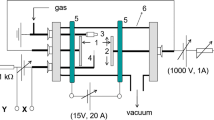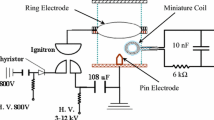Abstract
The hollow electrode Z-pinch (HEZP) is expressed as a new shape of Z-pinch devices in which one of the electrodes is ring-shaped. The periodic time of the discharge current is \(35\ \mu \hbox {s}\) with a total system inductance of 288 nH, total system resistance of \(14\ \hbox {m}\Omega \), and 34% deposited energy for a charging voltage of 8 kV. The pinch effect appears in the shape of a sharp spike in the signal of the discharge voltage and dip in the signal of discharge current, which leads to an increase in the plasma inductance at the pinch time. The plasma current density, which is measured using miniature Rogowski coil for 8 kV charging voltage and 1 torr pressure, has a maximum value of \(12.1\ \hbox {kA}/\hbox {cm}^{2}\) near the axis of the discharge tube and decreases toward the wall. The helium gas pressure in the range of 1–2 torr expresses the situation of the maximum current density. The pinch time increases by increasing the gas pressure and also by decreasing the charging voltage leading to a decrement of the peak discharge current and hence the magnetic field is also decreased. A delay time of at least \(4.1\ \mu \hbox {s}\) is found to be required to form the pinch for the implemented set-up of anode–cathode dimensions and interdistance. The calculated sheath velocity is in the range of 1.2–\(6\ \hbox {cm}/\mu \hbox {s}\) which is directly proportional to the charging voltage and inversely proportional to the gas pressure.












Similar content being viewed by others
References
M G Haines, Plasma Phys. Control. Fusion 53, 093001 (2011)
C Moreno, H Bruzzone, J Martinez and A Clausse, IEEE Trans. Plasma Sci. 28, 1735, (2000)
R A Vesey, M C Herrmann, R W Lemke, M P Desjarlais, M E Cuneo, W A Stygar, G R Bennett, R B Campbell, P J Christenson, T A Mehlhorn, J L Porter and S A Slutz, Phys. Plasmas 14, 056302 (2007)
M K Matzen, Phys. Plasmas 4, 1519 (1997)
M E Cuneo et al, Phys. Plasmas 8, 2257 (2001)
M G Haines, S V Lebedev, J P Chittenden, F N Beg, S N Bland and A E Dangor, Phys. Plasmas 7(5), 1672 (2000)
V V Aleksandrov, E V Grabovski, A N Gribov, A N Gritsuk, S F Medovshchikov, K N Mitrofanov and G M Oleinik, Plasma Phys. Rep. 35(2), 136 (2009)
V D Selemir, Plasma Phys. Rep. 33(5), 381 (2007)
R G Jahn and W Von Jaskowsky, AIAA J. 2, 1749 (1964)
E Torbert, I Furno, T Intrator and E Hemsing, Rev. Sci. Instrum. 74, 5097 (2003)
S H Ishii, T Hara, F Sonoda, M Fukuta and I Hayashi, Elect. Eng. Jap. 106(3), 487(1986)
F Dothan, H Riege, E Boggasch and K Frank, J. Appl. Phys. 62, 3585 (1987)
Sh Al-Hawat, M Akel and S Lee, J. Fusion Energy 30, 494 (2011)
M E Abdel-kader, M A Abd Al-Halim, A M Shagar, H A Eltayeb, H A Algamal and A H Saudy, J. Fusion Energy 33, 53 (2014)
H Bruzzone, A Clausse, M Barbaglia and H Acuna, Plasma Phys. Control. Fusion 54, 012001 (2012)
Y P Zhao, S Jiang, Y Xie and Q Wang, Appl. Phys. B 99, 535 (2010)
M Akel and S Lee, J. Fusion Energy 32, 111 (2013)
M Akel, S Lee and S H Saw, IEEE Trans. Plasma Sci. 40(12), 3290 (2012)
S Lee, S H Saw, L Soto, S V Springham and S P Moo, Plasma Phys. Control. Fusion 51, 075006 (2009)
M N Sharak, S Goudarzi, A Raeisdana and M Jafarabadi, J. Fusion Energy 32, 258 (2013)
M A Abd Al-Halim and M S Afify, Eur. Phys. J. D 57, 71 (2017)
A Kanani, M N Nasrabadi, B Shirani and I Jabbari, Pramana – J. Phys. 85(1), 149 (2015)
M Z Khan, L K Lim, S L Yap and C S Wong, Pramana – J. Phys. 85(6), 1207 (2015)
Z Ali, S Lee, F D Ismail, Saktioto, J Ali and P P Yupapin, Procedia Eng. 8, 393 (2011)
Marek J Sadowski and Marek Scholz, Nucleonika 57, 11 (2012)
K T Lee, S H Kim, D Kim and T N Lee, Phys. Plasmas 3, 1340 (1996)
T E Markusi, K A Polziny, J Z Levinez, C A McLeaveyx and E Y Choueiri, AIAA J. 17, 3257 (2000)
M Keidar, I D Boyd, N Lepsetz, Th E Markusic, K A Polzin and E Y Choueiri, 37th AIAA \(/\) ASME \(/\) SAE \(/\) ASEE Joint Propul. Conf. (Salt Lake City, UT, July 8–11, 2001) AIAA 2001-3898
P C Sleziona, M Auweter-Kurtz and H O Schrade, Proc. 23rd IEPC (Seattle, WA, USA, 1993) p. 609
R A Serway and J W Jewett, Physics for scientists and engineers with modern physics, 8th edn (Brooks\(/\)Cole, Belmont, CA, 2010)
S Lee, Appl. Phys. Lett. 95, 151503 (2009)
R Verma, R S Rawat, P Lee, A T L Tan, H Shariff, G J Ying, S V Springham, A Talebitaher, U Ilyas and A Shyam, IEEE Trans. Plasma Sci. 40(12), 3280 (2012)
F Veloso, C Pavez, J Moreno, V Galaz, M Zambra and L Soto, J. Fusion Energy 31, 30 (2012)
M E Abdel-kader, M A Abd Al-Halim, A M Shagar and A H Saudy, Eur. Phys. J. D 68, 160 (2014)
D G Fearn and E R Wooding, Brit. J. Appl. Phys. 18, 213 (1967)
M Emami, Laser Phys. 17(1), 1, (2007)
A Donges, G Herziger, H Krompholz, F Ruhl and K Schonbach, Phys. Lett. A 76, 391 (1980)
M Mathuthu, T G Zengeni and A V Gholap, IEEE Trans. Plasma Sci. 25, 1382 (1997)
H Schmidt, Nucleonika 46, 15 (2001)
Author information
Authors and Affiliations
Corresponding author
Rights and permissions
About this article
Cite this article
Aser, M.S., Abdel-Kader, M.E., Shagar, A.M. et al. Characterisation of electric discharge in hollow electrode Z-pinch device by means of Rogowski coils. Pramana - J Phys 91, 22 (2018). https://doi.org/10.1007/s12043-018-1594-1
Received:
Revised:
Accepted:
Published:
DOI: https://doi.org/10.1007/s12043-018-1594-1




